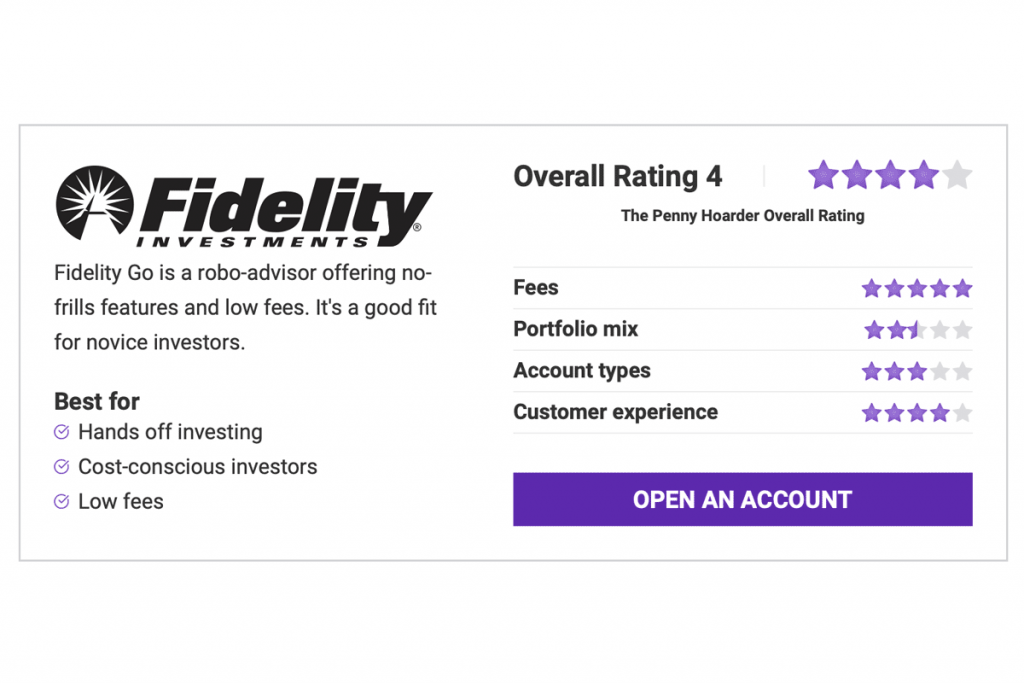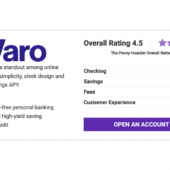Fidelity Go is a robo-advisor offering from a reputable brokerage with low fees. There is no advisory fee for those who have balances lower than $10,000 and all investors can access Fidelity’s mutual funds with no expense ratios.
As the robo-advisor arm of the Fidelity Investments family, Fidelity Go features automated investment portfolios composed of Fidelity Flex funds (yup, they’re fee free) and no minimum opening balance. It also doesn’t charge any advisory fees for balances less than $10,000.
Like other robo-advisors, Fidelity Go investors will start by filling out a short questionnaire based on information about your goals, finances, and risk tolerance. Some of these questions include your birth year, and what you’re investing for (like retirement or a non-retirement goal).
The platform will also ask you to rate your risk tolerance based on a scale from one to 10, with 10 being the most aggressive and one being the least. More aggressive investors will usually have a higher percentage of stocks in their portfolios, whereas it’ll veer towards more bonds the more conservative you want to be.
Once that’s complete, the robo-advisor will use the answers to create an investment portfolio based on your individual needs.
If you’re not sure if you want to commit to Fidelity Go, you can fill out the questionnaire and be able to see a sample investment portfolio. That way, you can get a feel for what it might be like to invest with this robo-advisor before proceeding with the rest of the sign up process.
Fidelity Go at a Glance
There are a number of features that you will want to consider before opening account. Our list of the pertinent information for each will help you decide if Fidelity Go is the right brokerage for you.
Investors can open both individual and joint taxable accounts, plus IRAs (Traditional, Roth, and Rollover). If you have an existing Fidelity account, you can easily integrate your investments with Fidelity Go.
There’s no minimum opening deposit if you want to open a Fidelity Go account, but you’ll need to put in $10 or more to start investing.
Fidelity Go doesn’t charge any commissions for any of their trades.
The following are the advisory fees it’ll charge based on your account balance:
Aside from that, there are no additional fees. In most cases, investors are required to pay expense ratios for the underlying securities in their portfolios. Since this robo-advisor uses fee-free Fidelity Flex funds, there are none.
Investors have a choice between 14 portfolio options — half are retirement portfolios, and the rest are taxable. No matter which you choose, they’re created from Fidelity Flex funds.
These funds have holdings across four asset classes including U.S. stocks, international stocks, domestic bonds, and short-term securities. How much each of these funds will be in your portfolio will depend on your goals.
Keep in mind there are no assets such as commodities, real estate investment trusts and international bonds to choose from. Still, you can get a decent amount of diversification if you’re not bothered by the lack of these additional choices.
Considering they’re all no-fee funds, you’ll be able to save money compared to other robo-advisors, assuming you’re paying less in advisory fees. Fidelity Go will also conduct a review annually to ensure the current investment strategy works for you.
Fidelity Go will start allocating your money into various asset allocations based on your questionnaire — it’s hands-off for you from here. The robo-advisor will have their financial advisors rebalance your portfolio whenever market fluctuations veers your asset allocation off course.
The robo-advisor doesn’t offer tax loss harvesting, a tactic where a brokerage offsets capital gains by selling losing investments. However, Fidelity GO does purchase municipal bonds for their taxable accounts, and these tax-advantaged securities may be able to minimize your taxes.
Investors can keep up to date with their investment portfolio by signing up for monthly email alerts.
Customers can opt into opening a cash management account. Any cash in your Fidelity Go portfolio that’s idle will be swept into the Fidelity Government Cash Reserves automatically. That way, customers can benefit from better rates compared to what you find with other brokerages.
Fidelity Go customers can contact representatives 8 a.m. to 6 p.m. ET, Monday to Friday either logging into their account and using the live chat feature, or by calling 1-800-343-3548.
Fidelity Go is a great fit for those who are looking to dip their toes in investing with a robo-advisor or are more into hands off strategies. It’s also a great fit for those who initially don’t have a large chunk of money to invest because accounts with balances under $10,000 won’t need to pay advisory fees.
A major advantage of Fidelity Go is you’ll be able to see how your money will be spread out across the robo-advisor’s recommended asset allocations. If you like what you see, great. If not, you don’t need to commit to anything.
The platform is fine if all you want is a basic service offering low costs and no expense ratios, and you can tailor your asset allocation based on your financial goals and risk tolerance. Fidelity is a reputable brand, and those who want additional services like access to human financial advisors, more advanced investing offerings can do so since they have a Fidelity account.
Keep in mind you’ll need to start paying advisory fees once your balance reaches $10,000 or more. Still, the fees are competitive, and slightly lower than competitors.
However, if you’re looking for a more robust robo-advisor with perks such as access to human financial advisors, you’re out of luck. This option is useful if you’re looking for more personalized guidance on retirement and other financial goals. Paying more in advisory fees may still be cheaper than opening an account with Fidelity Go and hiring a separate financial advisor (compare costs before doing anything).
While it may not be a big deal, the lack of real estate, commodities, and foreign bonds may be off-putting to others. Plus, although Fidelity Flex funds are low-cost, they may feel limited depending on your investing goals.
Don’t forget Fidelity Go doesn’t engage in tax loss harvesting — if you’re worried about paying a lot in capital gains, consult a financial professional to see how it’ll affect your bottom line. It may be happy enough that Fidelity Go’s use of municipal bonds in taxable accounts.
Overall, Fidelity Go is a decent offering, but make sure to compare other brokerages before making your decision.
Look over our assessment of Fidelity Go’s pros and cons to decide if this is the right robo-advisor for you.
We’ve rounded up answers to common questions about Fidelity Go.
The fee is usually a percentage of your balance, though there may be brokerages that charge a flat monthly fee. If you’re charged based on a percentage, it could mean you’ll pay more in fees the higher your balance.
Contributor Sarah Li-Cain is a personal finance writer based in Jacksonville, Florida, specializing in real estate, insurance, banking, loans and credit. She is the host of the Buzzsprout and Beyond the Dollar podcasts.
Ready to stop worrying about money?
Get the Penny Hoarder Daily
Privacy Policy
© 2021 The Penny Hoarder. – All rights reserved.
Privacy Policy and Terms of Service | Do Not Sell My Personal Information | Cookies Settings






